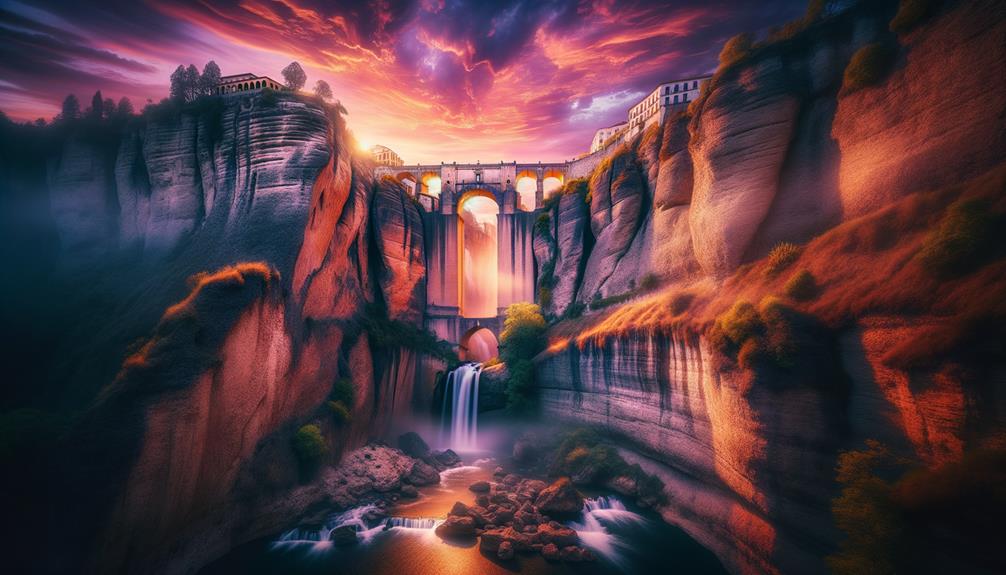Standing on the edge of the Puente Nuevo Bridge, I felt a deep connection to the past, gazing down into the depths of El Tajo Gorge. The bridge's elegant single arch seems to hold secrets of 18th-century determination and resourcefulness. As I ran my fingers over the worn stones, I couldn't help but think about the dark periods it has witnessed, particularly during the Spanish Civil War. The contrast between its architectural beauty and its haunting history left me pondering the complexities that lie beneath its surface. What other stories does this iconic structure hold?
Puente Nuevo Overview
Standing majestically over the 120-meter-deep chasm of El Tajo in Ronda, Spain, the Puente Nuevo is a testament to the ingenuity and perseverance of 18th-century engineering. As I approached this monumental bridge, I was struck by its grandeur and the meticulous craftsmanship that went into its creation. Completed in 1793, the Puente Nuevo is the newest and largest of the three bridges that span the dramatic gorge, connecting the city's older and newer districts.
The vision of architects like José Garcia and the tireless efforts of countless workers culminated in this architectural marvel. The bridge's robust stone arches seem to defy gravity, standing as a testament to human tenacity and architectural innovation. Above the central arch, there's a chamber that holds secrets of its past use as a prison during the civil war, a stark contrast to its current role housing an exhibition on the bridge's history and construction.
Walking across the Puente Nuevo, I felt a deep connection to Ronda's rich cultural heritage. The bridge isn't just a passage over a gorge; it's a link between centuries of history and the spirit of a resilient community.
Construction History
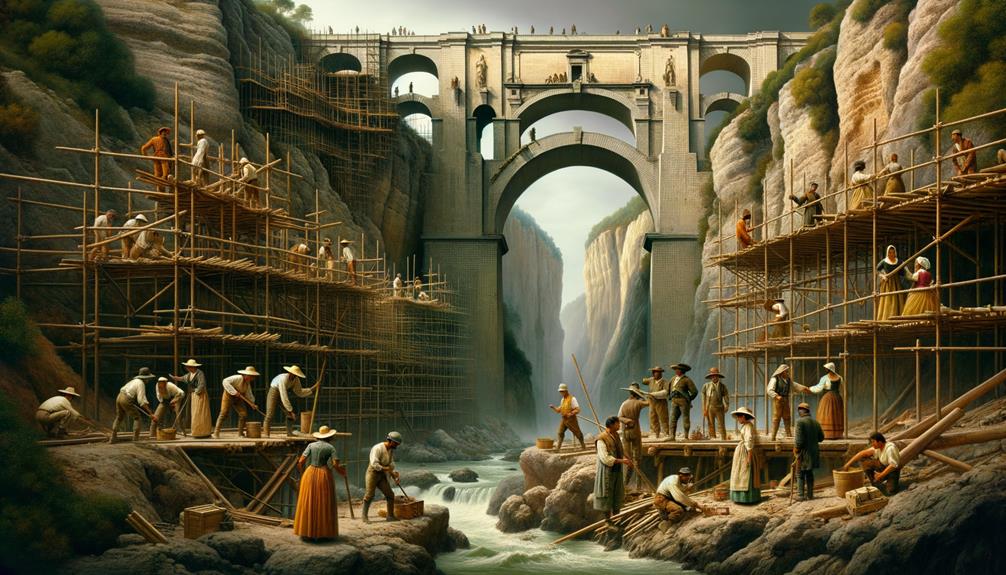
When I first learned about the original 1735 bridge collapsing in 1741, I was struck by the engineers' determination to span the dramatic El Tajo gorge. They redesigned the bridge with a single arch, a bold move that demonstrated their unwavering commitment. Despite the construction challenges they faced, Puente Nuevo finally stood triumphant in 1793, a testament to their unrelenting spirit.
First Bridge Collapse
In 1735, Francisco Gutiérrez took on the ambitious project of building the first Puente Nuevo, a bridge that would ultimately collapse due to its inadequate foundations. The picturesque town of Ronda, perched atop a dramatic gorge, needed a bridge to connect its divided parts, and Gutiérrez envisioned a grand structure that would rise above the chasm. However, the rushed and poorly executed foundation work couldn't support the weight and grandeur of the bridge.
I imagine standing on the edge of that gorge, hearing the echoes of the collapse – a poignant reminder of nature's power over human creations. The collapse in 1741, just six years after its completion, must have been devastating for the townsfolk and a humbling experience for the builders.
Years later, renowned architect José Martín de Aldehuela would step in with a vision that finally brought the dream of the Puente Nuevo to life. His careful planning and innovative designs guaranteed that Ronda's bridge would stand the test of time.
Single Arch Design
The vision of a single arch in Ronda's Puente Nuevo bridge embodies not only structural ingenuity but also the city's enduring spirit and architectural mastery. This iconic bridge rose from the ashes of a collapsed predecessor, symbolizing Ronda's tenacity and determination.
As I walk across Puente Nuevo, I'm struck by the seamless blend of function and form. The single arch design distributes weight evenly, offering unparalleled stability. This innovative approach was crucial after the previous bridge's collapse, proving that Ronda could learn from its past and build something lasting.
Completed in 1793 after 34 years of meticulous construction, Puente Nuevo's single arch has stood the test of time. It spans the dramatic El Tajo gorge, connecting two parts of the city and showcasing human ingenuity. Standing on this architectural marvel, I feel a deep connection to Ronda's history, a tribute to what can be achieved through perseverance and visionary design.
Construction Challenges
Confronting numerous construction challenges, the building of Ronda's Puente Nuevo stands as a testament to the resilience and ingenuity of its architects and laborers. The journey was marked by setbacks, from the collapse of the first bridge in 1741 to the strained financial circumstances of 18th century Spain. Architect José Martín de Aldehuela took on the formidable task in 1785, determined to overcome the obstacles that had previously thwarted success.
The financial crisis of the time meant working with poor quality materials, pushing the team to their limits. Yet, these master stonemasons, often without formal training, displayed exceptional skill and determination. Their efforts culminated in the completion of the bridge in 1787, a testament to their perseverance.
Initial collapse: The first Puente Nuevo, built by Francisco Gutiérrez, fell in 1741 due to inadequate foundations.
Financial constraints: Low fixed-price budgets restricted material quality and availability.
Architectural vision: José Martín de Aldehuela's innovative design ultimately succeeded where others had failed.
Skilled labor: Master stonemasons, despite lacking formal education, executed the complex construction flawlessly.
Community impact: The city's dissatisfaction with earlier attempts underscored the importance of a robust and lasting structure.
In every stone and arch, Puente Nuevo tells a story of tenacity and creativity, embodying the spirit of those who built it.
Architectural Significance
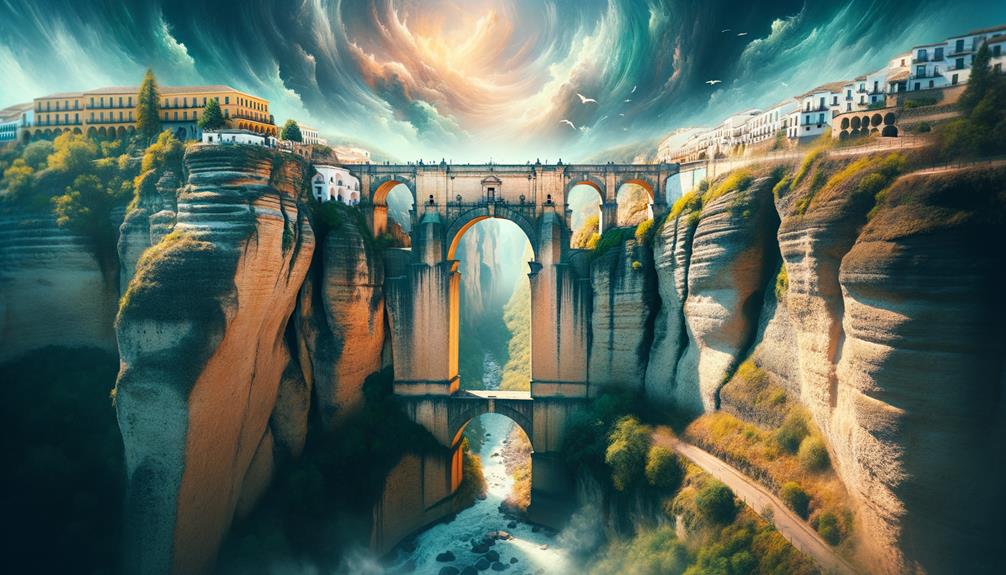
The Puente Nuevo bridge, with its imposing single arch spanning the dramatic El Tajo gorge, is a testament to Ronda's rich architectural heritage and the ingenuity of 18th-century engineering. Architect Domingo Lois de Berge designed this masterpiece, completed in 1793, marking a significant milestone for the city. The bridge's single arch design not only showcases the era's architectural prowess but also connects the old and new parts of Ronda, blending history and modernity seamlessly.
As I walk across the Puente Nuevo, I marvel at its robust yet elegant structure. The arch, soaring above the gorge, seems to whisper stories of the skilled craftsmen and builders who brought this vision to life. There's a palpable sense of historical significance here – each stone meticulously placed, each curve purposefully designed. The bridge doesn't just connect two landmasses; it bridges centuries of cultural evolution.
Visitors are drawn not just by its scenic appeal but by its symbolic representation of human creativity and perseverance. It's a landmark where past and present coexist, inviting everyone to pause and appreciate the freedom in architectural expression.
Dark History
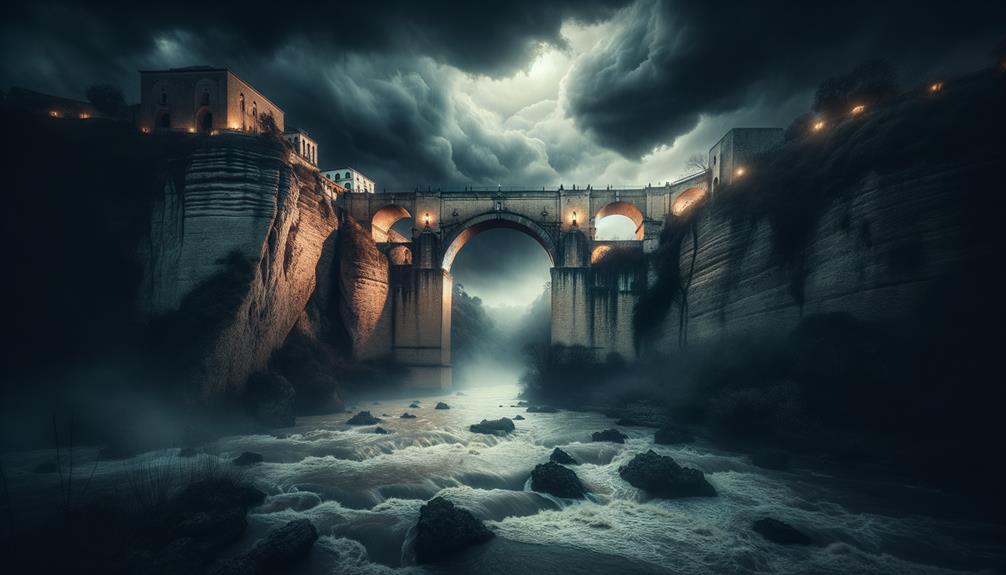
Standing on the Puente Nuevo Bridge, I feel a chill run down my spine as I recall the dark stories from the Spanish Civil War. The chamber above the central arch was a place of brutal terror, where political prisoners were imprisoned and often met a horrific end, some even being thrown to their deaths from the windows into the gorge below. Ernest Hemingway's novel vividly captures this grim reality, painting a stark picture of the political turmoil that once gripped this beautiful town.
Civil War Executions
Amidst the echoes of history, the chamber above Puente Nuevo's central arch holds haunting memories of the brutal civil war executions that transpired within its stone walls. This space, serving as a prison during the 1936-1939 civil war, became a grim theater of human suffering. The dark shadows cast by the conflict still linger, revealing tales of a torture chamber.
The chamber windows, once offering a serene view of the landscape, became portals to despair. Prisoners, subjected to unimaginable torment, faced their final moments here. The stark contrast between the bridge's architectural beauty and its harrowing history is a poignant reminder of humanity's capacity for both good and evil.
- Prison: The chamber held prisoners of war, many of whom would meet a tragic end.
- Torture Chamber: The room allegedly witnessed acts of torture during the civil war, leaving an indelible mark on its history.
- Civil War Executions: Many were executed within these stone walls, their lives cut short by the conflict.
- Chamber Windows: Some prisoners met their fate by being thrown from these very windows, a grim reminder of the brutality that took place.
- Historical Inspiration: The dark events that unfolded here inspired scenes in Hemingway's 'For Whom the Bell Tolls,' a testament to the power of human experience.
Standing in this chamber, one can't help but feel the weight of history, a somber reminder of the cost of freedom and the resilience of the human spirit.
Prisoner Deaths Plunge
Gazing out from Puente Nuevo's chamber windows, it's hard not to think about the prisoners who were thrown to their deaths, a grim reminder of the bridge's dark past. The chamber above the central arch, which served as a prison and rumored torture chamber, silently witnessed the atrocities of the 1936-1939 civil war. The cold stone walls still seem to reverberate with the anguish and despair of that time.
During that turbulent period, prisoners faced unimaginable suffering. Rumors of torture and cries of pain filled the air before some prisoners met their tragic end, cast into the abyss below. These horrific acts inspired literary giants like Hemingway, who drew inspiration for scenes in 'For Whom the Bell Tolls' from this very place, where life and death hung precariously in the balance.
Standing here, I'm struck by the longing for freedom that must have consumed those imprisoned within these walls. The bridge's dark history serves as a somber reminder of the devastating cost of conflict, forever etched into the fabric of Ronda's majestic yet haunting landmark.
Political Turmoil Impact
The Spanish Civil War left a lasting impact on Ronda, with the Puente Nuevo bridge serving as a haunting reminder of the era's brutal history. During the 1936-1939 conflict, the chamber above the bridge's central arch was used as a prison, and rumors suggest it was also a torture chamber. The picturesque arches of the bridge conceal the dark secrets of a traumatic past, where prisoners faced unimaginable horrors.
Ernest Hemingway drew inspiration from this very spot for scenes in his novel 'For Whom the Bell Tolls.' The stark contrast between the bridge's beauty and its blood-stained history is striking. It's said that some prisoners met their end by being thrown from the chamber's windows into the gorge below, a chilling reminder of the cruelty of war.
Key points about Puente Nuevo:
- The chamber above the central arch was used as a prison during the civil war.
- Rumors suggest it was also a torture chamber.
- It inspired scenes in Ernest Hemingway's 'For Whom the Bell Tolls.'
- Unfortunate victims were thrown into the gorge below.
- The bridge's dark past contrasts with its picturesque surroundings.
As you walk across Puente Nuevo today, you can't help but reflect on the layers of history and the resilient spirit of those who endured such times.
Visiting Puente Nuevo
Walking across Puente Nuevo, you're immediately struck by the stunning views of El Tajo Gorge and Ronda's rich history. This marvel of engineering spans a deep 120-meter chasm, linking the old and new parts of the city. As you stroll along, the ancient Puente Romano comes into view, a reminder of Ronda's complex past.
Above the central arch of Puente Nuevo, an exhibition explores the bridge's history and intricate construction. For just €2, I stepped inside to learn more. The exhibition offers a fascinating look at the ingenuity and ambition that shaped this landmark.
Standing on the bridge, I felt a profound sense of freedom. The city of Ronda spreads out on either side, with its whitewashed buildings and winding streets telling stories of centuries past. The vistas from Puente Nuevo are breathtaking, with the El Tajo Gorge carving a dramatic path through the landscape. Each step across the bridge felt like a journey through time, connecting the present with the past.
The bridge's central arch houses an exhibition that delves into its storied past and intricate construction. I spent €2 to step inside and immerse myself in the narrative. The exhibition provides a unique glimpse into the ingenuity and ambition that shaped this landmark.
As I stood on the bridge, I felt a deep connection to Ronda's history. The city sprawls out on either side, with its whitewashed buildings and winding streets whispering tales of centuries gone by. The views from Puente Nuevo are unparalleled, with the El Tajo Gorge dramatically cutting through the landscape.
Nearby Attractions
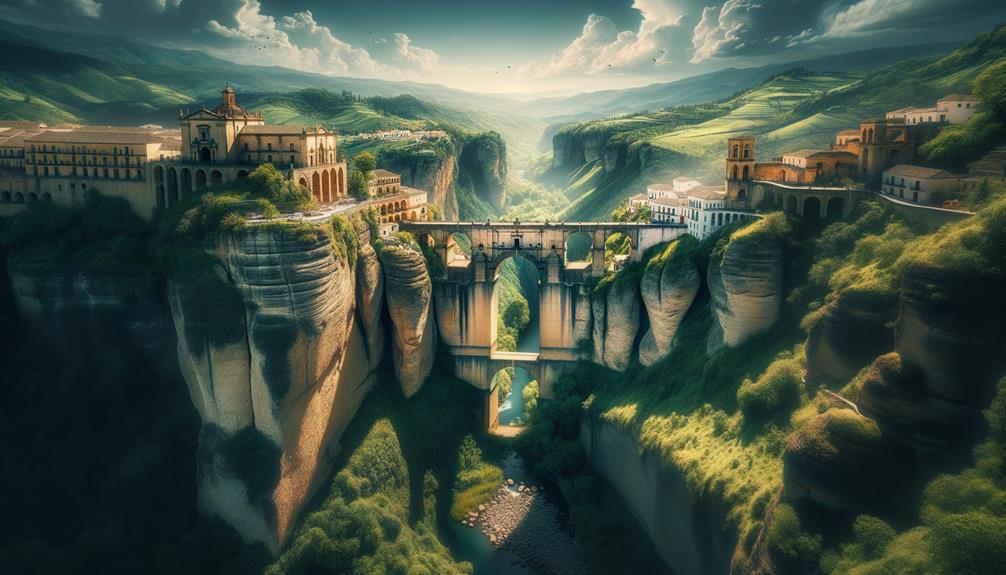
As I left the majesty of Puente Nuevo behind, my curiosity led me to explore Ronda's other treasures. I started with the charming Puente Viejo, nestled nearby. This ancient bridge, also known as the 'Old Bridge,' spans the Guadalevín River and offers a quieter, yet equally enchanting, glimpse into Ronda's storied past. Walking across Puente Viejo, I felt like I was stepping back in time, surrounded by the rugged beauty of the landscape.
Venturing further, I discovered the allure of Ronda's old town, where narrow, winding streets and whitewashed buildings tell tales of centuries gone by. The vibrant market quarter, El Mercadillo, invites exploration and offers a taste of local life. What I found particularly captivating was:
Puente Viejo, a historic bridge with captivating views.
The serene flow of the Guadalevín River beneath both bridges enhances the natural beauty.
Ronda's old town, with its cobbled streets and historic buildings, provides a rich cultural immersion.
El Mercadillo, a bustling market quarter full of local flavors and sounds.
Hidden courtyards, small, serene spots perfect for a moment of reflection.
Each step through Ronda revealed layers of history and culture, making the journey through its streets an unforgettable experience.

